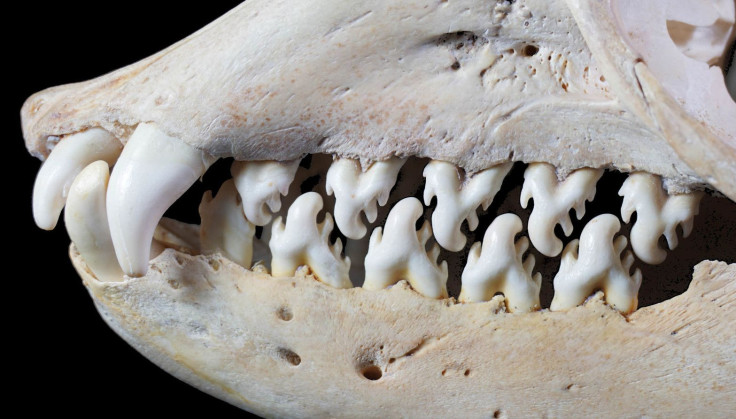Prehistoric Whales Had Knife-Like Teeth To Tear Apart Prey

Whales were a lot more fearsome during prehistoric times, if their knife-like teeth are any indication.
A team of scientists has suggested that the ancestors of baleen whales, the modern world’s largest animals, snapped around the ocean with teeth as sharp as what you would find in the mouth of a terrestrial meat-eater. According to a paper in the journal Biology Letters, these munchers “were capable of capturing and processing prey,” rather than passively filter-feeding like their descendants that roam Earth’s oceans these days.
The authors assert that these creatures evolved with sharp teeth perhaps because they had “a feeding strategy that included both biting and suction,” in which they were both drawing in and biting down on their prey.
The teeth often had multiple sharp protrusions, with a shape reminiscent of an animal’s paw or the flames of a fire.
#NewPaper: Did the teeth from early fossil whales work like a sieve? @emgfitzgerald @DrTeethAl @museumsvictoria https://t.co/CXG4WalUu8 pic.twitter.com/M4teteBFB0
Baleen whales have since lost these sharp teeth, and rely now on filter feeding to satiate their hunger. In that process, they suck in material and bristle-like structures in their jaws, positioned where teeth would be, filter their meal for them. Baleen contain keratin, the protein in human hair and fingernails.
The most well-known kinds of baleen whales include humpback whales, blue whales and gray whales, among others. Toothed whales, on the other hand, include animals that are classically identified as whales — like the sperm whale and the orca, also known as the killer whale — as well as dolphins, vaquitas and other porpoises. These two classes of whales split off from each other on the evolutionary tree about 34 million years ago.
How baleen whales went from the toothed creatures they once were to the filter-feeding ones they are today is a bit of a mystery. Some have said that the odd-shaped teeth of the ancient counterparts were used to filter food, just in a different way from modern baleen.
To better understand the transition, this team of scientists took a closer look at how sharp the prehistoric teeth were, as a way to explain their function and compare it to different animals both in the sea and on land.
#Fossil tooth from our new study! Sharp tips & notches allowed Janjucetus to cut & pierce prey! @museumsvictoria https://t.co/CXG4WalUu8 pic.twitter.com/83QO4tkAOn
They found that the sharpness of their teeth was similar to land-based carnivores and predatory seals, suggesting that the archaic whales were using their teeth for “piercing and cutting capabilities,” according to the study. The teeth “show no trend toward a filtering morphology” because they do not have a blunt and notched structure that you would find, for example, in a filter-feeding seal.
These super-sharp teeth that prehistoric whales had were not the only thing that would set them apart from the whales of today, two of the scientists from the study team wrote in The Conversation. They were also much smaller — only about 10 to 16 feet long, while some modern whales can be longer than 100 feet. They transitioned into the giants that grace today’s oceans somewhere along the way, at the same time their teeth were disappearing.
“Among living marine mammals, including whales, dolphins and seals, the ability to suck is almost universal, and the same may well have been true for their extinct forebears,” the scientists wrote. “Living suction feeders have broad snouts and small mouths, which help maximize the strength of suction. Both features appeared in early whales.”
It’s possible that as the whales relied more and more on suction, their sharp teeth were lost to evolution, and baleen eventually evolved from there.
“These results are the first to show that ancient baleen whales had extremely sharp teeth with one function — cutting the flesh of their prey,” one of the researchers, Erich Fitzgerald, told Agence France Presse. “Contrary to what many people thought, whales never used their teeth as a sieve, and instead evolved their signature filter feeding technique later — maybe after their teeth had already been lost.”
© Copyright IBTimes 2024. All rights reserved.




















